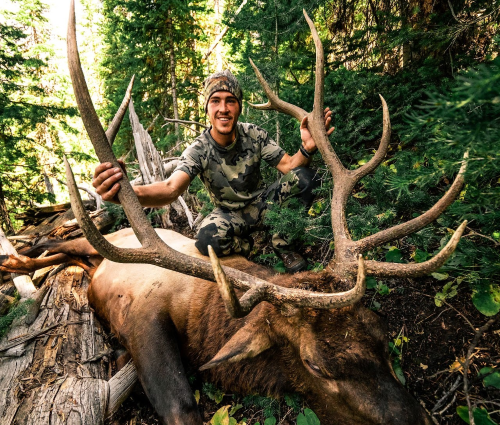FISH CATCHING TRAVEL
Brought to you by
**For a super deal on your Wade Right use promo code FCT15 and get 15% off on your online order!**
****************** Fresh or salt it has a place in your arsenal.
Fresh or salt it has a place in your arsenal.
*******************
Over the years while guiding and living in the Ozarks white bass fishing was an important part of my life. And over the 25 years I learned a few things about catching them early, often beating the crowd by using this simple methods. It would be hard to guess how many I have boated but it was hundreds and hundreds every spring for 20+ years, and the same deep water jigging each winter. Thinking about it I may have caught more numbers of them than anything else over my lifetime. They can easily be the most productive fish for time spent.
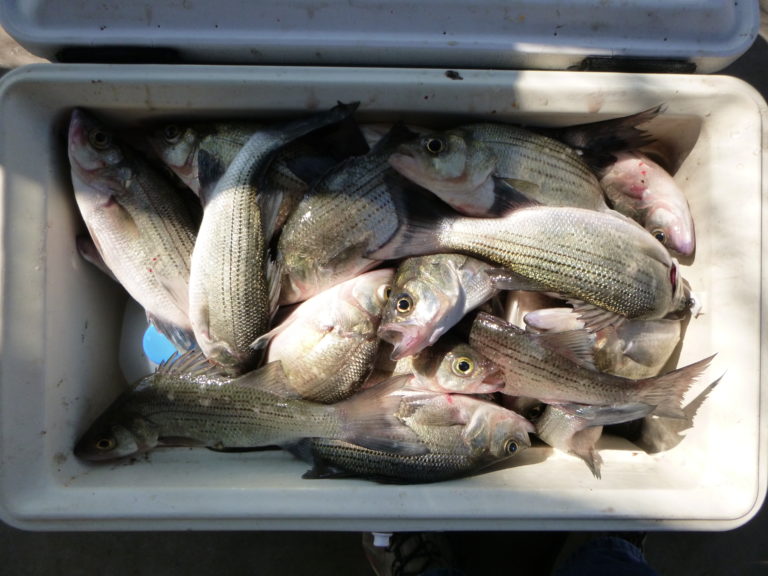 When the cooler is full time to hit the cleaning table.
When the cooler is full time to hit the cleaning table.
And with that I learned a pattern that can turn anyone into a early spring white bass Jedi Master. Whether it is Texas, Arkansas, or Timbuktu, white bass follow a simple pattern every year no matter where you are. Genetics drives them, the desire to spawn and repopulate the species takes over, and knowing when and where can put you on fish in nothing flat. The period is short and it is coming to a lake near you.
Water temperature plays a role, and that temp varies with the part of the country. And while it is important, it is not the driving force. A perfect example, Coleto Creek usually stays in the high 50’s to low 60’s like most power plant lakes. Many northern lakes freeze, and they move more predictably with the warming temps. So the important part of water temperature, is it rising, and is it your spring? Then they are coming no matter what. If the timing is right and you take these tips and put them in practice, I promise fish in the boat. (Brave thing to say huh?)
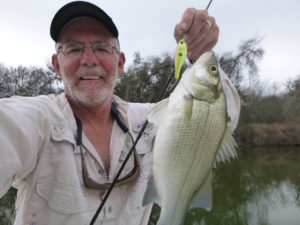 From a river near you.
From a river near you.
When they make their move they have only one place to go in most lakes and rivers, up the creek until even they might need a paddle. How far? All the freakin’ way, and thanks to that bit of information where should you start? How about all the way up the river or a bigger tributary/creek on the lake. Far enough you can’t go any farther up, as in bang the skeg on the bottom and you are there. In real terms we are talking when it finally gets to 5′ or less. As the great Buck Perry said, “The fish are deep, shallow, or somewhere in between.” In the case of white bass they will either be at the end of the line, a little down lake, or hanging in the deeper holes in the creek waiting to move. It is not rocket science, simply a matter of timing.
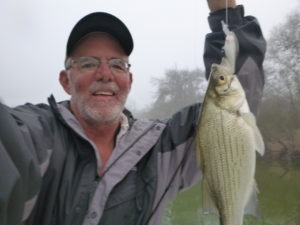 They grow them big on the Nueces.
They grow them big on the Nueces.
So the first decision, go to the closest ramp to the end of navigable water. Saves a ride on a cold spring day. Next, drive up the creek or river and keep driving until you are scared to go further, then go the last little bit and start fishing. Then simply keep fishing as you ease down lake/river. And don’t just drive willy nilly, pay attention to what and where the first fish bites. There are several ways to fish successfully, depending on your preference, so lets talk about simple ways to load the boat.
First a word or two on the topography up most creeks or rivers. On lakes there is always the old river channel, which usually means a flatter side, and the deeper side wherever the channel runs. And of course the usual holes on channel bends, where they often hold. Simply hanging in the channel/holes waiting for the right time, on the channel lips when getting active, and super shallow in the afternoon as the sun warms.
The one place that you find them when they are really getting busy is a shoal. Often in the straighter areas of the old creek or river bed where there were 2 channels with an island or high spot between them. That shoal or high spot is easy to find after you have made a couple of passes watching the locator. The best of them tend to be in 5′ foot of water. Pay attention to the edges, if you get a bite on a pass or two stop and toss something. It can be that easy. That is why having even a basic fish finder is the key to success.
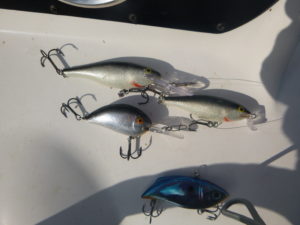 Rapala and Bagley both get the job done. And take note of the Bagley rattle bait.
Rapala and Bagley both get the job done. And take note of the Bagley rattle bait.
Trolling, is probably the most efficient and easy way to find them which is the most important thing in the early spring. Once you find them it is game on, end of story. And there are a couple of baits that will get the job done, it does not take a tackle box full of lures. The first by far is the Rapala Shad Rap. It has been a staple in my box for as long as I can remember. And the great thing, they are all specifically designed to fish a particular depth. Plus they are easy to cast and crank if that is your thing, but either way they smack it.
First I never leave the ramp without are a Shallow Shad Rap in a number 7, in any shad look I can find at the store, hopefully silver/black foil. They are a little hard to come by but it is a winner in this system. Why? It runs around 6′ foot or less on the troll depending on line size and speed, I generally troll with 10 or 12lb test. It is the perfect bait when you turn the boat around after hitting bottom and starting to fish your way down river.
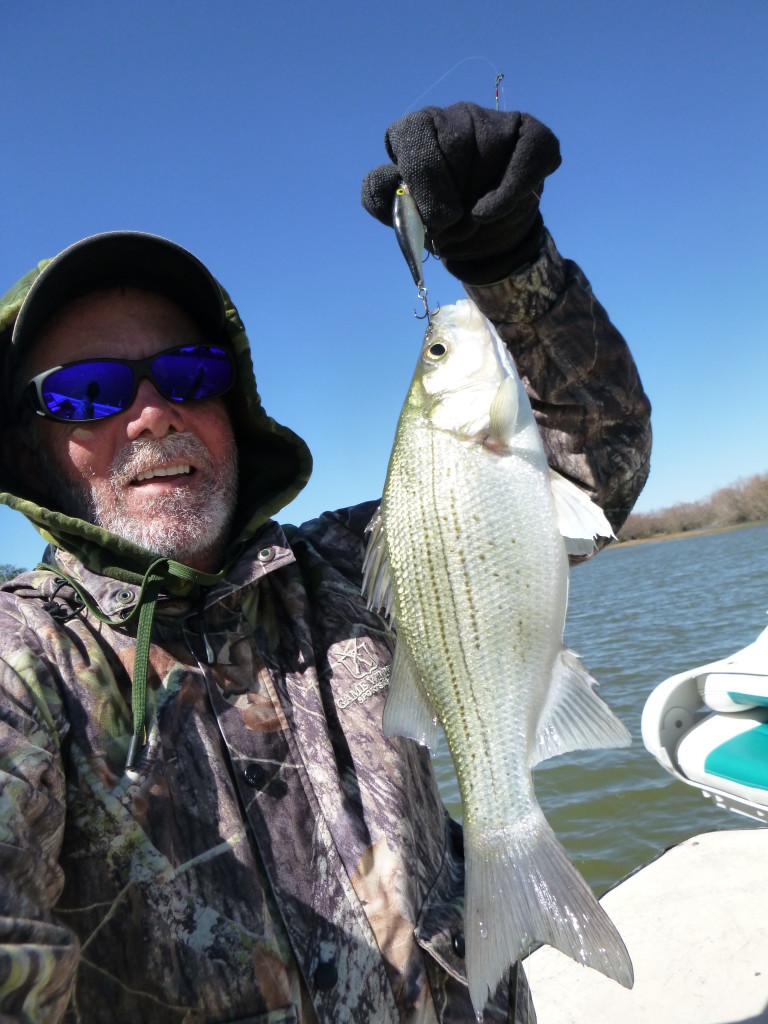 Coleto has a few, this is a big one for the lake.
Coleto has a few, this is a big one for the lake.
Cast it out, and let it get about 50′ behind the boat, check the drag (Keep it light.), and start trolling slowly. Usually for me at idle, or around 2.5 mph. It is nice to have another in a silver/black back that also runs the same. Just putt along and watch the locator. Usually when you find them you see them unless it is really shallow. As the water gets deeper then it is time to switch to a Rapala Shad Rap in the same size 7 and the Bagley, both will run to about 10′, maybe a little more. One thing I have learned about the spring run, when it is on those fish are almost always from 2′ out to 20″ downriver and the deep diving model 7 will cover everywhere you should be looking.
So the plan is simple, start shallow and go until you catch one. Gets a little deeper, switch from the shallow running to the regular Shad Rap. By doing it that way you cover lots of water, if they are not there yet it does not take long to figure that out. And the opposite, when they are there you will find that out quickly.
The second style bait, which I usually fish off another rod along with the Rapala is a Rattle Trap style bait. For this kind of fishing the particular company brand is irrelevant, nice 2 have a couple of different models, but it just has to be either a shad color or chartreuse. Most run around 6′ at the most on a slow troll, an area of water depth you need to cover if the day is really warming. Generally starting with the chartreuse Rattle Trap style bait is a good idea. You get not only a depth clue, but also a color clue. The fish will often settle a little more on one color or bait over the other, but it is usually a small difference in the early season run. They are on the chew.
You can also troll spoons, jigs, or plastics at slower speeds. And there is a world of shad imitation crankbaits, just pick a shad color, the important thing is to know the depths it runs. Basically no matter what you troll you are seining the water at specific depths to find them as quickly as possible. Then you can put the real hurt on them, by either keeping trolling, or switching to casting.
I did not troll much the first 2o years I chased them. But I caught literally thousands casting. That is the area I have the most experience. As soon as there was a hint of spring I was up (Where? See above.) one of the bigger creeks on Norfork and Bull Shoals looking for white bass. I often used crappies jigs, feather jigs, or small plastics on 6lb test. And there is “That Perfect Place” early spring when they begin to move up. A flat slowly slopping bank, softer bottom, in about 10′ of water, out of the wind, with the sun beating on it. Jackpot!That is when water temperature really matters so pay attention. A 5 degree difference n cool spring water can make all the difference. Simple enough, but as we all know the fish have not read the same book we have.
Just slowly hop the jigs along working from the bank out to the boat, hopping it along and letting it hit bottom occasionally. Anything from 1/16th to 1/4 ounce white will usually work. And they way they thump it is a good thing, a cool solid bite. And it is basically the same thing you can do if trolling and catch a few and then decide to cast the area.
From that point on, until the run is over, if you follow this plan you will find them, or they are gone. Most places I have caught them this is the case, one day they are there and the next they are gone. That is why this is about an early spring method. Once the run is done they become a completely different animal requiring different tactics. The time to go is now in south Texas.
I hope this helps if you want to try your hand at white bass fishing. It is such a good thing for kids or folks who can not cast. All they have to do is hold on. So get out there this year and sack a bunch. And remember this tip, cut out the red meat, soak them in 7Up the night before, they will melt in your mouth. So keep stopping in and thanks for reading my stuff.
Good Luck and Tight Lines
(Thanks for sticking with me while I have been out of action. And I will be taking my own advice tomorrow on Coleto. Let the fishing begin!)

